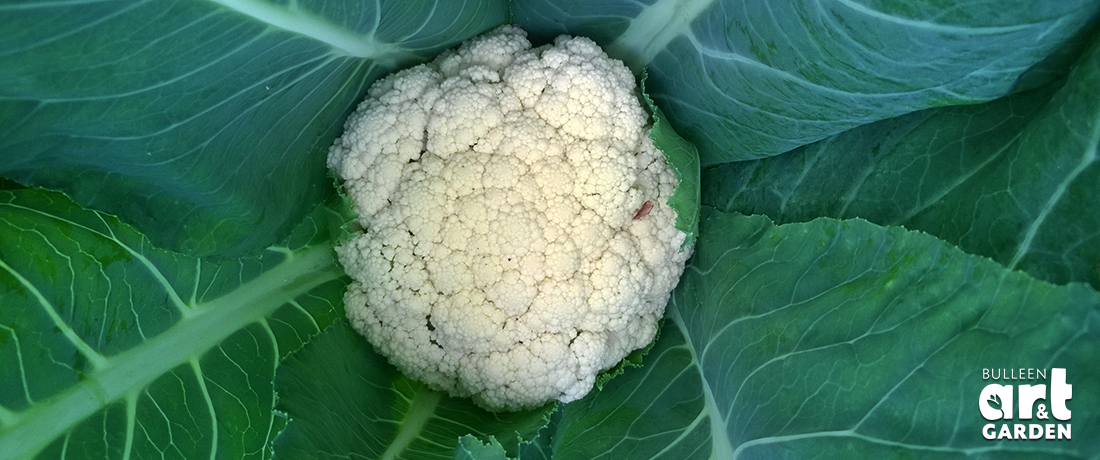
 Important note about plant availability. Important note about plant availability.There are hundreds of factsheets on our website provided for your information. Not all plants will be available at all times throughout the year. To confirm availability please call (03) 8850 3030 and ask for the nursery. |
Who can resist this great white wonder, especially in a baking tray covered in cheese! Although not the easiest of vegetables to grow, cauliflower is incredibly rewarding, looks great and is low in fat, high in folate, fibre and vitamin C.
Planting Time: Apr – Aug
Position: Full sun, no wind
Water Needs: Moderate
Difficulty: High
How Long: 12 – 16 weeks
With cauliflowers, the secret to success is position and timing. Choose a sunny position, protected from strong winds. When sowing seedlings, leave about 40cm between each plant.
Cauliflowers can be a bit fussy about their soil, so take a bit of time to prepare the
bed, about one month prior to planting. Ensure a well-drained soil, chock full of well-rotted compost and organic matter with a pH of 6.5-7. Correct soil pH should prevent a myriad of nutrient related issues, as will a light application of chook poo based fertiliser pellets when preparing the bed.
To minimise the risk of pests and diseases taking hold, ensure they are
not planted into a bed that has had cabbages, broccoli, brussel sprouts or other members of the Brassiacea family within the last three years.
Depending on the variety of cauliflower you plant, leave at least 40cm between each seedling, but, to allow for them to grow to their full potential, the more space you can allocate the better.
Feed your cauliflower weekly with a seaweed or compost tea, especially in the month leading up to harvest. As heads appear, a drink from your worm farm liquid will improve size and shape of the heads.
Cauliflower will become stressed if not watered deeply and consistently. It is important to ensure water reaches the roots, so, if area is mulched, consider subsurface irrigation or pull mulch away when watering. Avoid wetting foliage, as this is an open invitation for mildews to move in. Cauliflowers will suffer badly in waterlogged soil, so ensure good drainage and check soil moisture BEFORE watering.
Cabbage white butterfly and their caterpillars are a pain for most members of this family (cauliflowers included), especially if the weather is still mild. As a preventative, place white egg shells in the garden, or make some sticks with strips of white plastic bag tied to the top in a “bow tie” fashion. Both of these will confuse the Cabbage White Butterfly, and she will move on without laying her eggs on your cauliflowers.
As a safe and effective last resort, (as even environmentally friendly sprays should be used with discretion) spray your plants with Dipel or Success, which are both made from a naturally occurring bacteria that’s particularly harmful to caterpillars, but safe for other insects and mammals. Wait 3 days after spraying before picking for eating. Keep an eye out for snails, and, if problems arise, whack down a beer trap and catch them.
Cauliflowers can also get a bit pummeled by aphids, so place a few bright yellow plastic dishes (like Vegemite lids), half filled with water, near your crop. Aphids are strongly attracted to yellow but are not great swimmers. This is a safe, chemical free alternative to traditional aphid control, and works a treat in Brassica patches.
Depending on the cauliflower varieties planted, they can take anywhere from 12 weeks upwards before they are ready to harvest. Look for firm, tight, well-formed
heads that have not begun to flower. Cut off heads with a sharp knife as required. When cooking, dunking lightly cooked cauliflower into cold water will halt the cooking process and keep the florets bright and crisp!
Whack into a patch with good friends like: dill, sage, mint, nasturtium,
rosemary, beetroot, beans, lettuce and cucumber.
Avoid planting cauliflowers with: garlic, rue, tomatoes and strawberries.
 Important note about plant availability. Important note about plant availability.There are hundreds of factsheets on our website provided for your information. Not all plants will be available at all times throughout the year. To confirm availability please call (03) 8850 3030 and ask for the nursery. |
Paleface: Slow to get going, but very rewarding when it does, Paleface produces large, white heads that are incredibly tasty. Does quite well in cooler spots.
Snowball: This cute little cauliflower is a fairly quick grower, and produces pure, white, tight heads to about 15cm. Good variety for pots and smaller patches.
Purple or Violet Varieties: Stunning looking cauliflowers, these guys are vigorous growers with gorgeous violet heads. Fine in cooler spots, purple cauliflower will change to green when cooked.
